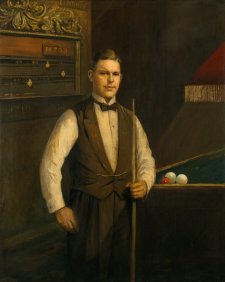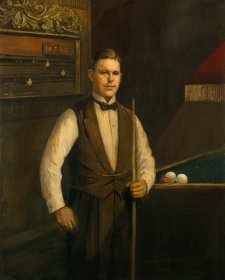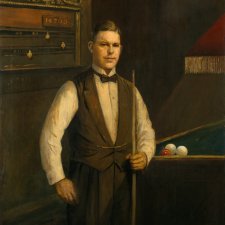Walter Lindrum OBE (1898–1960), billiard player, was born into family of billiard champions in Kalgoorlie, Western Australia, where his father ran billiard rooms and a bookmaking business. In 1921 the family moved to Melbourne, where they were to operate the Lindrum billiard hall for decades. Walter and his brother were coached by their father, Frederick, who, according to Walter, was the best billiard player in the pre-World War 1 world. Walter’s brother Frederick, too, was brilliant at the game, but fate saw Walter emerge as the dominant player internationally. In 1929 he went to England, where he quickly established himself as the greatest the world had seen. He made his largest competitive break, of 4 137, in 1932. The 1930s were his peak years; he won the world billiards championship in 1933 and retained the title throughout the decade. In the 1940s, he abandoned competitive play. Apart from writing about billiards, in his later years he applied himself to raising funds for Melbourne charities. His much-visited grave in Melbourne General Cemetery is in the form of a billiards tabletop, complete with cue and balls.
Will Longstaff (1879–1953) grew up in Ballarat, where he studied art at the School of Mines before embarking for the Boer War. Proceeding to Europe, he attended art school in London. He joined the Australian Imperial Force in 1915, serving in Egypt before being invalided to England, where he was appointed a war artist and worked in camouflage and the Australian War Records Section. His best-known painting, Menin Gate at Midnight (1927) hangs in a curtained shrine-like space in the Australian War Memorial. A resident of England for the rest of his life, Longstaff undertook many portrait commissions. He is thought to have painted Lindrum in London in 1932, the year Lindrum made his record break.
Purchased with funds provided by L Gordon Darling AC CMG 2006
L Gordon Darling AC CMG (38 portraits supported)



On one level The Companion talks about the most famous and frontline Australians, but on another it tells us about ourselves.



A portrait story exploring the life of Walter Lindrum, one of the greatest billiard players of all time.



Walter Lindrum, world-famous billiards player, was one of Australia's greatest sporting champions.